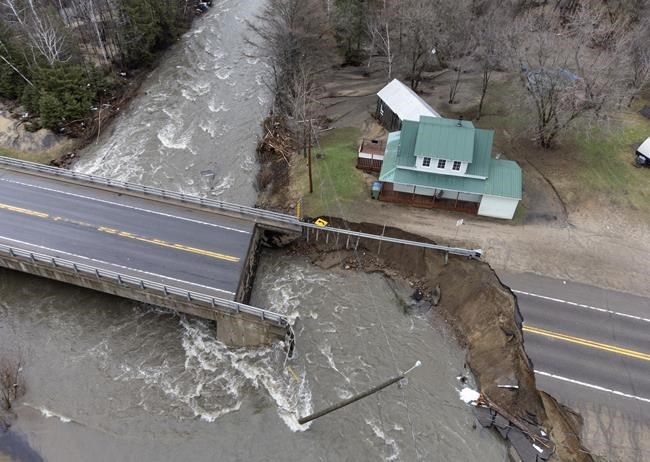BAIE-SAINT-PAUL, Que. — Search and rescue teams spent Tuesday scouring muddy riverbanks and flying through cloudy skies northeast of Quebec City for signs of two missing firefighters who were swept away in floodwaters during a rescue mission.
Meanwhile, communities across Quebec declared states of emergency as heavy rains washed out roads and cut off homes, leading to striking images of swollen rivers carrying away recreational vehicles and tearing apart infrastructure.
Public Security Minister François Bonnardel flew Tuesday into St-Urbain, Que., in the Charlevoix region, where a day earlier two first responders disappeared while helping flooded residents. The two volunteer firefighters were well-known in the community, he said.
“We still have to have hope," Bonnardel told reporters. "We are doing all that we can to find these missing people; we know that it is not easy, everything that's happening in a community that's so tightly knit."
Specialized aerial and ground rescue teams were looking for the men, provincial police Sgt. Beatrice Dorsainville told reporters. Search teams included police divers, Canadian Coast Guard members and dozens of officers on the ground, she added.
Environment Canada said the Charlevoix region received between 70 and 100 millimetres of rain over a 36-hour period and was expected to get another 10 mm to 20 mm by Wednesday.
Earlier in the day, Bonnardel travelled to Baie-St-Paul, Que., a city under a state of emergency just south of St-Urbain, where he said the worst had likely passed but the situation would remain complicated for the coming days.
"We may have some precipitation, some rain for the next 24 to 48 hours, so we're still looking at and monitoring the level of the river," Bonnardel said about the swollen Rivière du Gouffre, which tore apart roads in the region and left homes isolated. The floodwaters from the Rivière du Gouffre sliced in half Highway 138, the main road in the region, leaving residents stranded on either side.
Footage of the flooding captured by onlookers shows recreational vehicles being swept away by the river. But for the owner of the Genévrier campground — an important tourist destination in the community — the floodwaters washed away a family-run, 50-year-old business.
“It's 50 years of work by the family to build a business that is a jewel of the Charlevoix region in terms of tourism business with great fame and reputation," an emotional Bruno Labbé said Tuesday. "To see so much work destroyed in such a short time, there are no words to describe it."
Labbé said the river moves at a good clip when it rains, but never as fast as it did this week.
“The river completely burst its banks and entered the campground, much of the land was flooded," Labbé said. During the summer, the camp welcomes as many as 3,000 motorhomes. Labbé said the damage is in the millions of dollars, adding that he wasn't sure whether he would rebuild.
Baie-St-Paul Mayor Michaël Pilote told reporters Tuesday that about 600 people had been forced from their homes because of the flooding, adding that some might be able to return once a bridge linking the east and west parts of the city is reopened. Later in the day, officials confirmed that traffic had resumed across the bridge.
Everist Prokofiev, a Baie-St-Paul painter, said he was waiting to regain access to his recently renovated art galley to inspect it for flood damage. Residents were expecting rain, he said, but not to the extent witnessed this week.
"The mood went from one of amazement, watching Mother Nature with the rushing river, and then you saw the rubble coming, the trees, the telephone poles, refrigerators, pieces of houses," Prokofiev said.
"And then the water started rising, and that amazement we had from Mother Nature turned to terror pretty quick, because that rushing water is like nothing else … the rumbling sound of so much water, it's terrifying."
Charlevoix is one of several parts of the province hit hard by flooding after a period of heavy rain, with some communities in the region declaring states of emergency, including in St-Côme, Que., in the Lanaudière region, north of Montreal. Town officials were not available for interviews, but one local resident described the situation this week as shocking.
"The water level rose so fast,” said Mariève Paradis, co-owner of a sports store. The 45 centimetres of snow on the ground about one week ago melted quickly, she said, leading rivers and lakes to swell rapidly.
"It's unheard of," Paradis added about the speed the water rose. "Even the mayor said he had never seen something like that, that people who have lived in that area for more than 50 years and it has never happened."
Quebec's Public Security Department said five communities in Lanaudière had declared states of emergency, including Chertsey, St-Jean-de-Matha and Mandeville. Fort Coulonge, in western Quebec, was also under an emergency declaration.
The department reported major flooding along the Ottawa River at Baie Quesnel, just west of Montreal, and along the Rivière du Nord in St-Jérôme, about 60 kilometres northwest of Montreal. In Lachute, Que., and nearby St-Jérôme, 15 to 30 mm of rain was expected to fall by Wednesday.
André Cantin, meteorologist at Environment Canada, said the Laurentians region and Lanaudière had received between 50 and 75 mm of rain since the weekend, adding that more showers were expected later Tuesday.
This report by The Canadian Press was first published May 2, 2023.
— With files from Sidhartha Banerjee and Marie-Ève Martel in Montreal.
Thomas Laberge, The Canadian Press




